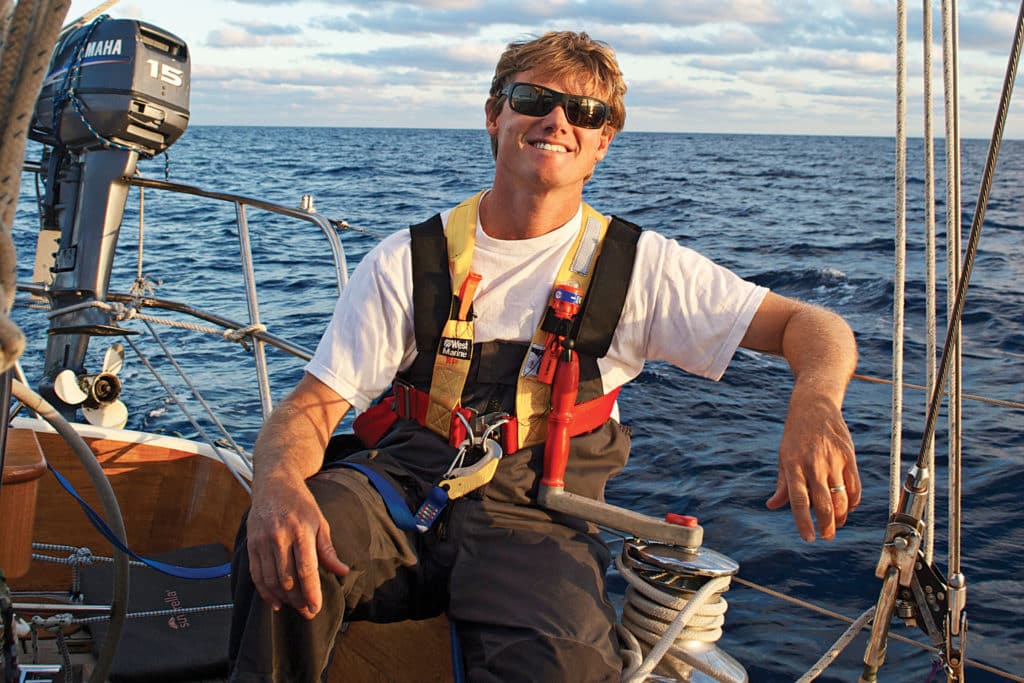
Clipped and tethered in
Many articles have been written about how to maneuver your sailboat to reach and retrieve overboard crew, but it’s rare to see advice on how to make sure no one goes over the side in the first place.
At 6 knots a sailboat will travel about 200 yards in a minute. That’s why it’s imperative to have a man-overboard pole, life ring, strobe light and small EPIRB or PLB all secured together and stored so they can be instantly launched. Organize your man-overboard drills, but just as importantly, make plans to stay onboard.
This requires rigging full-length jacklines port and starboard. I prefer to use wire, not flat webbing, which is subject to UV degradation. But that’s a personal choice. Many sailors prefer webbing, which won’t roll underfoot. If you use webbing, inspect it regularly and coil it up and store it in a locker when it’s not in use.
Tethers should be long enough that a crewmember can go from one side of the boat to the other without unclipping. If someone wants a short tether, a second, shorter one can be used, or a snap can be installed in the middle of a long one. Aboard my 1905 yawl, Iolaire, crewmembers were able to reach the end of the bowsprit to the end of the mizzen boom without unclipping.
When going below, the crew should not unclip until they are halfway down the companionway. When they do, they should unclip the tether from their harness and leave it on deck and attached to the jackline to be ready for use if suddenly called on deck. Coming up from below, the crew should clip on while still in the companionway.
Having a safety harness built into the life jacket is a big plus because when the weather is bad enough to require a harness, it will be bad enough to require a flotation device.
The Street family raised four children on Iolaire. They never wore life jackets (though these days it’s required that children do); rather the children wore harnesses attached to a line secured to a padeye amidships. The line was long enough that they could reach the bow or the stern. They would clip on before coming out of the hatch, and stayed clipped on until they were back below.
In even moderate weather, anyone on the foredeck working with the spinnaker or spinnaker poles should wear a harness and be clipped on.
Most lifelines are 24 inches high — just the right height to catch a person at the knees and dump them overboard! For this reason, on Iolaire I insisted that if anyone hauled on a line or cranked a winch, one knee had to be on the deck. Then if they were thrown off balance and tossed against the lifeline, it would hit them on the shoulder and not trip them up.
When a sailboat is heeled, crew going forward should go up the windward side. If they slip, they’ll have the deck below them to grab onto.
Offshore, I prefer staysails be cut low, almost to deck level. This makes the sail more efficient, and in heavy weather if someone falls on the foredeck, the low-cut sail will keep them aboard. When furling the mainsail, always be on the weather side of the boom so the billowing sail can’t blow you over.
It goes without saying that you need to rig an easily connected, easily disconnected main boom preventer before setting off. Every year people are injured or killed in accidental jibes.
And finally, men need to stop relieving themselves over the rail. After many years of worrying about this problem I came up with a solution. I took a quart-size Clorox bottle, cut out the bottom and tied a short length of 1/8-inch flag halyard around the neck. Then I secured the other end of the line to the side of the cockpit. Men bail ship standing in the cockpit, dump the business over the side, rinse the Clorox bottle and return it to the hook.
This article first appeared in the May 2014 issue of Cruising World. Don Street has countless transatlantic sails and Caribbean voyages in his wake, all without anyone taking a trip over the side because he insists that crew heed this advice.








